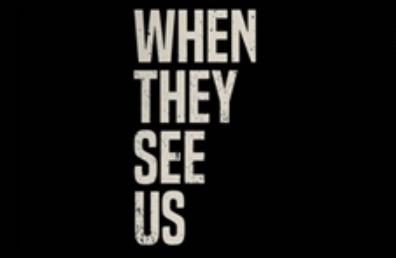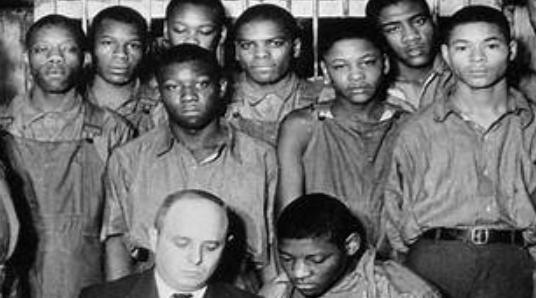*Introduction: The spring of 1989 was a pivotal year in New York journalism. For five relative dark-skinned males, life in New York would never be the same.
Said males were accused of assaulting a 28-year-old white female named Trisha Meili that would end in their felony conviction for rape and a violent beating of her person (link). In the aftermath, youths Kevin Richardson, 14, Raymond Santana, 14, Antron McCray, 15, Yusef Salaam, 15, and Korey Wise 16 known as the Central Park Five were convicted by New York prosecutors.
In an effort to rescue truth and alleviate the stress of the Central Park Five, Ava DuVernay, years later memorialized their pain and wrongful conviction on film. The vehicle she recently produced to accomplish such a feat precipitated the release of a Netflix production titled “When They See Us” that reentered what had occurred decades ago into the current public domain (https://www.hollywoodreporter.com/review/they-see-us-review-1211524).

Statistics: As per statistical data, according to the FBI whites (5,753,212) are arrested for more total crimes than blacks (2,197,140). In fact, blacks are arrested 38% of the total crimes for which whites are arrested. Blacks account for 27% of national arrest totals while whites account for 70% of such totals. Therefore, whites are arrested for crimes more than twice the rate of blacks (https://ucr.fbi.gov/crime-in-the-u.s/2015/crime-in-the-u.s.-2015). What’s more “blacks and Latinos were nine times as likely as whites to be stopped by the police in New York City in 2009, but, once stopped, were no more likely to be arrested” (https://www.city-journal.org/html/distorting-truth-about-crime-and-race-10730.html).
Further statistical evidence suggests that while blacks comprise 55% percent of all police stops in 2009, their portion of the New York City population is less than half at 23%. Additionally, while whites comprise 10% of New York’s police stops they comprise 35% of its population (https://www.city-journal.org/html/distorting-truth-about-crime-and-race-10730.html).
When they see us: The case of the Central Park Five is not a judicial anomaly but is in fact a prosecution protocol when race i.e.: skin color is involved (https://www.nytimes.com/2017/06/26/nyregion/central-park-jogger-case-honorary-diplomas.html). On March 25, 1931 near the town of Scottsboro and Jackson County, Alabama where violence had reportedly broken out a virulent demonstration of racism erupted. Eventually nine black male youths were arrested for a minor charge. Similar to the Central Park Five they were relatively dark-skinned and mere boys ranging in ages from 13 to 19 years. Following their arrest police questioned two white women, reported to have been prostitutes named Ruby Bates and Victoria Price (https://www.history.com/topics/great-depression/scottsboro-boys). Fearful of being charged, the two women accused the boys (13 to 19 years old) of raping them.
JIMMIE WALKER TO LEBRON, KYRIE & KD: ‘STOP COMPLAINING, STOP GETTING POLITICAL!’ – WATCH

At the culmination of prosecution in April of 1931, an all-white, all-male jury immediately found the nine black boys guilty and sentenced eight of them to the death penalty. The adjudication of the 13-year-old child named Leroy Wright ended in a hung jury. This hung decision was incurred by one member of the white jury who preferred life imprisonment rather than putting the child to death.
Years later, the Alabama judicial system allowed four of the Scottsboro Boys to be granted parole. In 1948, one escaped from prison. Eventually, he was taken into custody by the FBI in Detroit, Michigan. Alabama requested his extradition back to its jurisdiction. However, the governor of the state of Michigan refused the request to extradite. Subsequently, he remained in the state of Michigan until his death in 1952. His accomplice received a pardon from the Governor of Alabama George Wallace in 1976 who lived to the age of 76. Decades later in 2013, the Board of Pardons and Parole for the state of Alabama unanimously agreed to pardon the boys posthumously (https://www.cnn.com/2013/11/21/justice/alabama-scottsboro-pardons/index.html). Such a pardon act contrasted with the leniency accorded white defendants.
When We See Them: Stanford University in California is one of the most prestigious of elite institutions in the nation. Those admitted to its programs are among the essentially privileged and financially able of society. With few exceptions, they are also white i.e.: light-skinned. In a reversal of skin color as a conduit of criminal prosecution the case of light-skinned Stanford University student, Brock Turner offers dramatic evidence of leniency via the assumed virtue attributed to Turner’s light skin.

While in the act of committing rape, Turner had been witnessed by two international graduate students attending the University from Sweden. The victim they encountered was described by them as unconscious and “half-naked.” In the rescue of the victim, the two Swedish graduate students gave chase to Turner. Once they apprehended him, they detained Turner, until such time as the police arrived.
On February 2, 2015, Brock Turner pleaded not guilty to five felony charges. They consisted of “attempted rape, rape of an intoxicated person, rape of an unconscious person, sexual penetration of an intoxicated woman and sexual penetration of an unconscious woman” (https://www.usmagazine.com/celebrity-news/news/brock-turners-stanford-rape-case-everything-you-need-to-know-w209237/).
Of the five charges, Turner pleaded not guilty, two were dropped: the rape of an intoxicated person and rape of an unconscious person.
On March 30, 2016, Turner was officially convicted of raping an inebriated, unconscious Stanford Coed. For this crime, he faced a maximum of 10 years in prison. Prosecutors requested six years of incarceration despite the maximum possible of 10. At the conclusion of the trial, despite community outrage, Judge Aaron Persky sentenced Turner to six months. Additionally, Turner was to serve three years on probation. In this way, known by the Judge, Turner would be sparred custody at a state penitentiary where hardened criminals were housed requiring at least a year of incarceration by the State of California.
After universal criticism for leniency by the Judge, he proceeded to offer the outraged community a rationale. It was his contention that up to the point of the crime Turner had a clean criminal record as a model citizen. The subsequent conclusion according to the Judge was that any harsher sentence would have a “severe impact” on Turner. Such racial empathy conforms to a judicial pattern.
On July 3, 2019, the NYT reported on the case of a 16-year-old arrested on charges of rape. Judge James Troiano of New Jersey’s Superior Court withheld the boy’s name and photograph from public access. Apparently, this defendant had assaulted an intoxicated 16-year-old girl in the basement of a party they both had attended. “The boy filmed himself penetrating her from behind.” After recording the assault on cellphone video the defendant then posted the assault online with the text: “When your first time having sex was rape.” Unfortunately, Judge Troiano denied that such an assault was rape. He complimented the defendant as coming from a “good family.” For this commentary the judge was later rebuked by an appeals court thereby making way for a grand jury to try the defendant as an adult (https://www.thedailybeast.com/rape-accused-teen-shown-leniency-by-judge-because-he-comes-from-a-good-family). Absent photographic access, the historical pattern for such cases assures that the defendant is white i.e.: light-skinned as is the judge who presided where light skin was idealized.
Skin Color as Conduit of Criminal Prosecution: Despite the presumed validation of race as scientific, aside from skin color it remains a bogus non-scientific construct. Attributed to social science and its influence upon American institutions the more objective attribute of skin color is subjugated by the falsehood of race. When false convictions such as the Scottsboro Boys and the Central Park Five are adjudicated subsequent discourse attributes it by race to racism when in fact it is by skin color colorism. Today, colorism is a prevalent issue manifested by skin color in all manner of judicial operations.
Evidence of skin color as a conduit of criminal prosecution is verified in the investigations of sociologists Viglione, Hannon and Defina. Viglione, Hannon and Defina assessed the perception of skin color by correctional officers as pertains to maximum sentence and actual time served. Their investigation consisted of 12,000 black women incarcerated in the North Carolina prison system between 1995 and 2009. After controlling for several variables they conclude that black women assessed as lighter-skinned received more lenient sentences and served less time incarcerated. The existence of such investigations establish conclusively that skin color is in fact a conduit of prosecution as in cases of the Scottsboro Boys and the Central Park Five where dark skin was demonized (https://www.sciencedirect.com/science/article/pii/S0362331910000923).
Conclusion: While the solution to false convictions must address skin color in the demonization of dark skin at every social and institutional level, its initiation must first permeate scholarship of the social science academy. Moreover, “race” as a deceptive quantification of human category must be eliminated entirely from the treatise of criminal prosecution. “When they see us” will then be no more or less nefarious to the judicial process “than when we see them.”
As an internationally known scholar, Dr. Ronald E. Hall testified as an expert witness in the nation’s first skin color discrimination case involving African Americans i.e.: Morrow vs. IRS. Shortly after he co-authored the widely read Color Complex: The Last Taboo Among African Americans. In 2003 Dr. Hall received the Adele Mellen Prize for Distinguished Contribution to Scholarship for Skin Color as a Post-Colonial Issue Among Asian-Americans. Because of his expertise, Dr. Hall has been sought after by various agencies for lectures at home and abroad including Stanford University (Palo Alto), McGill University (Montreal), Pennsylvania State University (State College), Oxford University (United Kingdom), and the U.S. Congress (Washington, D.C.). Dr. Hall’s work has been featured by numerous media such as TIME, The Boston Globe, The Atlanta Journal-Constitution, The Detroit News, The Chicago Tribune, Essence, The Sally Jesse Rafael Show, Oprah, and BET. In January 2015 Dr. Hall appeared in the Oprah Winfrey documentary “Light Girls” regarding skin color and African-American women. Additionally, Dr. Hall has worked as project associate for a number of urban education school projects focusing on issues related to school reform primarily in the state of Michigan. His role included oversight in the collection of qualitative data and conduct of focus groups. He has also served in the capacity of grant assessment for the National Science Foundation. Contact Dr. Hall via: [email protected].
We Publish News 24/7. Don’t Miss A Story. Click HERE to SUBSCRIBE to Our Newsletter Now!






